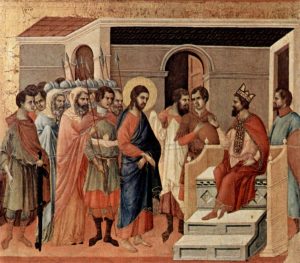A possible objection
Traditional attempts to explain Christian origins have had to rely on hypotheses about oral traditions (and more recently memory theory), on hypothetical constructions of long lost Christian-like communities. The letters of Paul have been read by and large at face value, ignoring the scholarship that should warn us that such a reading needs to be justified, not assumed. The gospels have been assumed, through circular reasoning, to be based on historical events. The explanation for Christianity I am proposing (having rediscovered the main conclusions of Roger Parvus via my own route with some prodding by Nina Livesey — though NL limits her case to the letters of Paul) has the advantage of being based on evidence we can see before us in the record. We can point to individuals, specific teachings and a historical context with strong explanatory power.
An immediate objection that comes to mind is that followers of various of these “gnostic” Christianities reinterpreted the same gospels we know in our Bibles. Surely these gospels came first, one might reasonably conclude. As an answer, I turn again to Nina Livesey’s point that the writings and teachings of the various schools were shared and debated among one another. We should also note that the canonical gospels pick up and re-work, re-interpret, teachings of the “gnostic” Christians that came before them. Just one instance of this is John 1:5
The light shone in the darkness and the darkness did not grasp it.

Saturninus taught that the unknown father god shone down on the creator angels (including the demiurge creator of Genesis) and those angels attempted but failed to grasp that light. So they decided to create a physical image of what they saw in that light — the first man. I owe that example of John 1:5 being related to the teaching of Saturninus to Simon Pétrement’s A Separate God but SP is assuming that the canonical gospel preceded Saturninus. Another example would be one pointed out by Matthias Klinghardt and Markus Vinzent: Marcion introduced John the Baptist in his gospel to epitomize the ultimate and final prophet of the Old Testament for whom Jesus was the antithesis; the Gospel of Mark and later canonical gospels re-interpreted Marcion’s Baptist to predict Jesus as the fulfilment of the law and the prophets. The Gospel of Luke includes a rather pointless scene of Pilate sending Jesus to Herod, only for Herod to return him again to Pilate. I cannot help but wonder if the evangelist is attempting to “answer” other narratives we know about that said it was Herod who crucified Jesus (Justin Martyr, Gospel of Peter). Hence the dialogue went both ways: each school reinterpreting what the others were saying.
Introducing asceticism
Continuing from A Beginning of Christianity? — A Closer Look in Antioch . . . .
Those who taught that the god who created the world was a lesser deity than the “Unknown Father” also taught, understandably, that it is better to live an ascetic lifestyle to avoid as much as possible contamination with the inferior creation. If marriage was an ordinance of the lower creator god, it followed that it was better to avoid marriage if possible. Similarly, the lesser god was responsible for killing, it was better to avoid eating what had been killed.
If ascetic practices went hand in hand with some of the anti-Jewish teachers of the early second century, the rejection of asceticism may be understood as a logical corollary of the opposing teaching that defended the physical creation as the work of the only God.
The author of 1 Timothy 4, on the other hand, defended the Creator God of Genesis as the supreme God, attacking those who, like Saturninus and Marcion, taught the necessity for an ascetic life:
The Spirit clearly says that in later times some will abandon the faith and follow deceiving spirits and things taught by demons. 2 Such teachings come through hypocritical liars, whose consciences have been seared as with a hot iron. 3 They forbid people to marry and order them to abstain from certain foods, which God created to be received with thanksgiving by those who believe and who know the truth. 4 For everything God created is good, and nothing is to be rejected if it is received with thanksgiving, 5 because it is consecrated by the word of God and prayer.
My point is that the teaching to avoid marriage and eating meat was part of the package that taught the Jewish Scriptures were the teachings of the “Jewish god” who was responsible for the law, suffering and injustice. The author of 1 Timothy stresses that the physical creation is good, not evil or the work of a lesser deity.
Most scholars deny that 1 Timothy was written by Paul. It was written by a “proto-orthodox” teacher who depicted Paul more in line with his image in Acts than the main letters. If the other letters of Paul were published by the school of Marcion (as per Nina Livesey’s new book) we find pointers to the same teachings, although muted by lines that appeared to contradict them. Opponents of Marcion accused him of deleting these passages but we are entitled to wonder if they had been added. See 1 Corinthians 7 for the discussion of marriage and Romans 14 for abstinance from meat.
It was not only Marcion and Saturninus who are said to have devalued the created world and advocated sexual and dietary asceticism. I hope to discuss others in upcoming posts because of the strong links they appear to have with our New Testament writings. One of these, Elchasai, has been discussed in depth as the founder of the “heresy” attacked in the epistles to the Galatians and Colossians — see the translation of Hermann Detering’s works.
